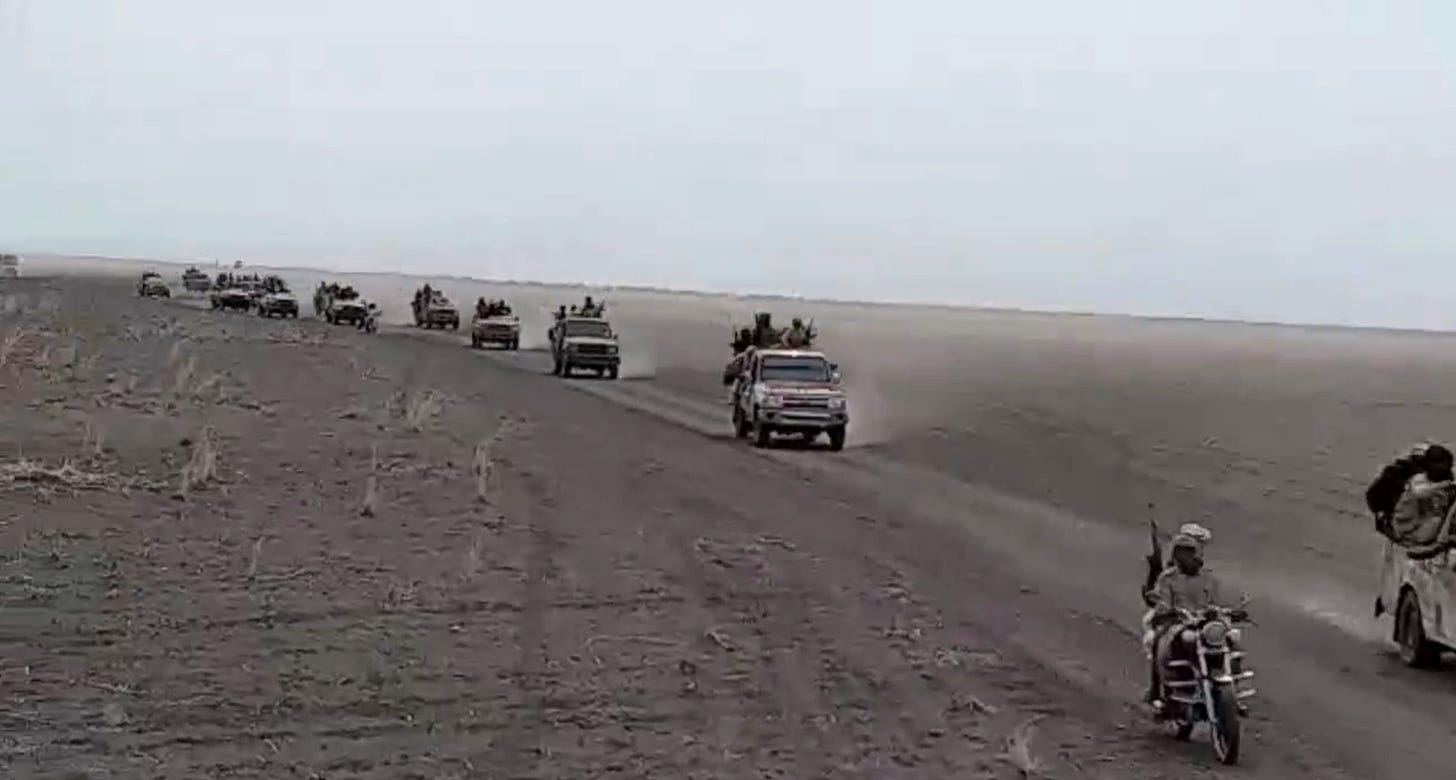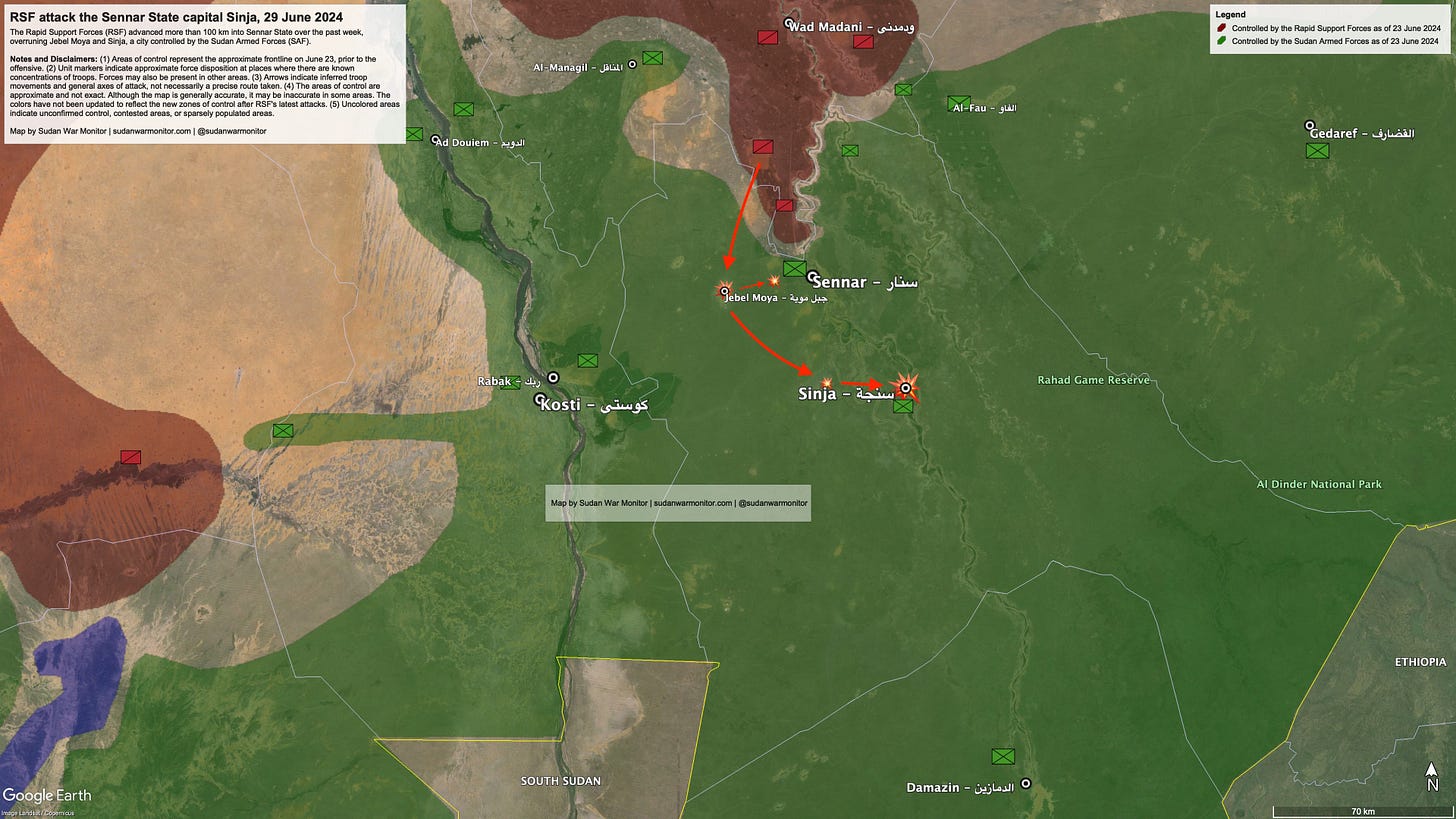Blitzkrieg: RSF advance deep into Sennar State and storm into the capital Sinja
Sudanese army loses control of state capital Sinja
Shocked residents scrambled to leave the Sennar state capital Sinja yesterday after the Rapid Support Forces (RSF) suddenly and unexpectedly stormed into the city, which lies in a fertile agricultural region along the banks of the Blue Nile.
After smashing the Sudan Armed Forces’ (SAF) defenses along a part of the Jazira-Sennar border at Jebel Moya last Monday, the RSF feigned an attack east toward the heavily defended frontline city of Sennar, before ultimately bypassing that city and advancing south through Sennar’s largely undefended agricultural plain.
Starting in the Jebel Moya area yesterday, June 29 (or during the prior night), the RSF advanced about 75 km to reach Sinja and quickly overran large parts of the city, including the headquarters of the 17th Infantry Division, the city’s main military base.
The attack happened after SAF had dispatched some of its reserves north from Sinja toward Sennar, leaving the city vulnerable.
Altogether, the RSF advanced approximately 115 km over the past week, including 40 km on Monday (June 24) and 75 km yesterday (June 29). The assault was led by Abdel-Rahman al-Bishi, a field commander with ties to Sennar State, and Abu Aqlah Keikel, the sector commander of RSF in Al Jazira State.
Geolocation of videos filmed by combatants confirmed RSF control at the army base, at the main police headquarters in the city, in the main market, at the state government secretariat, and elsewhere. During the night, clashes reportedly continued as SAF fought to retain control of southern parts of the city. At this time, we assess that the RSF control most of Sinja, notwithstanding claims from pro-SAF sources that they repulsed the attack or retook the city late yesterday.
Sudan’s army retains control of the frontline city of Sennar, but can no longer reinforce it from the south—only from the east. Four days ago we indicated in an analysis article that Sennar city was “at risk of partial encirclement,” adding that if this happened, “SAF would lose control of substantial parts of the Sennar State countryside.” (Sennar is the name of both the city and the state).
The city of Sinja has a population of approximately 250,000 people. Many of those who were able to flee went south toward Damazin, a city already hosting thousands of people displaced from the capital Khartoum and other areas. This will worsen Sudan’s already catastrophic humanitarian crisis.
Additionally, if the RSF extend their control in Sennar State, agriculture will be disrupted, deepening Sudan’s already severe grain shortage. International agencies that monitor famine risk recently have warned of an impending famine that could kill thousands of people in parts of Sudan in the coming three months, mostly in Darfur. The severity of this crisis is expected to abate in the final quarter of the year, as the harvest comes in. Less often talked about is the risk of an even deeper famine in 2025, caused in part by the spread of the war into Sudan’s most fertile regions.
Video of civilians fleeing Sinja
Video of RSF troops roaming through central Sinja
What next? Why this is a disaster for Sudan’s military
In addition to the humanitarian impact, the RSF attack on Sinja will have profound political and military consequences.
The last time a major city in the Nile Valley fell to RSF troops (Wad Madani in December 2023), it prompted widespread discontent with the army leadership, including a rare public rebuke from the leadership of the influential Islamic Movement.
A false but widespread narrative spread that the army had abandoned Wad Madani without a fight, stoking accusations of betrayal. In fact, they fought for four days on the Wad Madani outskirts before the defenses collapsed. Many prominent influencers who usually support the army called for a coup against Lt Gen Abdel Fattah al-Burhan, labelling him a coward or a traitor or incompetent. Such appeals again are being voiced in Sudanese online spaces in the immediate aftermath of the fall of Sinja.
Moreover, the defeat comes on the heels of RSF’s takeover of another state capital, Al-Fula of West Kordofan, just over a week ago on June 20. The loss of another two state capitals heavily damages the prestige of Sudan’s military government, draining public confidence and leaving the RSF now in control of eight of 18 state capitals.
In terms of military geography, the RSF advance into Sennar create major problems for the Sudan Armed Forces. Sinja lies along a key north-south route and is also home to one of the few bridges across the Blue Nile. Jebel Moya, which the RSF captured six days ago, lies along the Kosti-Sennar highway.
If the RSF retain control of these areas, it will be difficult for SAF to resupply or reinforce the 4th Infantry Division in Damazin, the 10th Infantry Division in Abu Jubeiha, or the 18th Infantry Division in Kosti. SAF would have to use back roads through villages in western Gedaref State to move supplies to these cities or use the Rahad Game Reserve or Dinder National Park, and the RSF could threaten these routes by extending their control east across the Blue Nile River.
Effectively, vast swathes of SAF-controlled territory in south-central Sudan would be cut off from the country’s east and its de facto capital at Port Sudan.
However, SAF still have a large number of troops and recruits in the populous southern states of White Nile and Blue Nile, and the RSF will not be able to capture these states without a fight. Additionally, not all of Sennar State has fallen, and Sennar City in particular can be reinforced from Gedaref and beyond.
In the coming days, SAF could attempt a counter-attack to retake Sinja. SAF’s inability to conduct maneuver warfare and its poor track record conducting offensive operations over the past year limit the likelihood of success, but in this case the stakes are particularly high.



